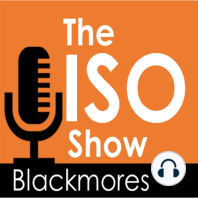9 min listen
#72 Carbon verification with ISO 14064
FromThe ISO Show
ratings:
Length:
23 minutes
Released:
Jul 2, 2021
Format:
Podcast episode
Description
If businesses aren’t talking about COVID-19, they are discussing how to become carbon neutral. To show their commitment to protecting the environment, companies are often claiming to be carbon neutral, but the issue is…where is the actual proof? Where is the credible framework that demonstrates that carbon verification? Today we’re excited to share how to get started with introducing ISO 14064 (the carbon footprint verification standard). So, if you're looking for a sustainability roadmap for your business and are wondering where to begin, then you’re in luck as we're going to be providing you with information on that over the next couple of podcasts! We’re delighted to be joined by David Algar, our resident Carbonologist at Blackmores, over the next few podcasts as he’s going to share with you information about the international standards that everybody's talking about when it comes to demonstrating your carbon neutrality. This includes ISO 14064 for carbon footprint verification and PAS 2060 on carbon neutrality. So, in this episode, let's kick off with ISO 14064 and find out what's it all about! What you’ll learn: What is ISO 14064? What are upstream and downstream emissions? Certification methods Benefits of ISO 14064 How Carbonology helps meet ISO 14064 requirements ISO 14064 is a specification with guidance at the organisational level for the quantification and reporting of greenhouse gas emissions and their removals. So, essentially, ISO 14064 is a standard for an organisation of any type, size, quantity, or location globally to quantify its emissions of greenhouse gases, with the end product of this being the creation of a greenhouse gas inventory. Now, let’s find out where we would begin with ISO 14064… In ISO 14064, the standard begins with defining the organisational boundaries and the reporting boundaries. So essentially what you're covering in your greenhouse gas inventory and what the reporting boundaries are. This will also include any exclusions you decide to make i.e. elements of your business that will not be have their associated GHGs quantified. An organisation embarking on its sustainability roadmap could carve out part of the business. So, for example by year one the UK operations, and then have a roadmap in place so that they include other locations and services as time goes on. David expands on the greenhouse gas inventory by highlighting that this is where you would document all your emission sources. So, they are divided up into scope one, scope two, and scope three sources. Scope one is the direct ones, so for example stationary or mobile combustion, or anything your organisation directly burns. Then it goes into scope two, which is your purchased energy (the electricity, steam, heating and cooling that you would use in the building that you own or lease). Finally going into scope three can be a bit more complicated. This would be your other indirect sources, upstream and downstream. For example, if you are a manufacturing company, the upstream emissions would be the emissions associated with activities, for example, before your products are delivered to your manufacturing or warehouse. So that would include the extraction of the raw materials, the processing, packaging, and then the transport and distribution. The upstream emissions associated with a vehicle, for example, include putting it in a cargo ship and shipping it across the world. So, once it leaves your warehouse or plant, it would then go off to the customer. This is where you are looking at the downstream emissions, including emissions associated with the product’s use The greenhouse gas inventory does split the scopes up for you, so you don't have to worry about memorising every single little part of the scopes! It is very useful in that aspect and it lays it out in a list for you. Let’s take a quick dive into the vertification options for ISO 14064… If you do decide to go for a third-party vertification from a certification boa
Released:
Jul 2, 2021
Format:
Podcast episode
Titles in the series (100)
Episode 3 - Your First ISO Assessment And What To Expect: Welcome to the ISO Show, dispelling myths and sha… by The ISO Show
